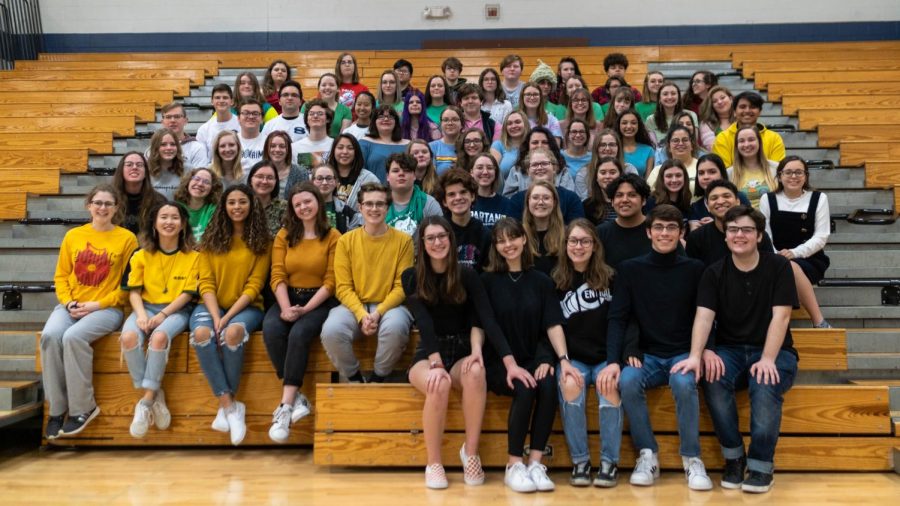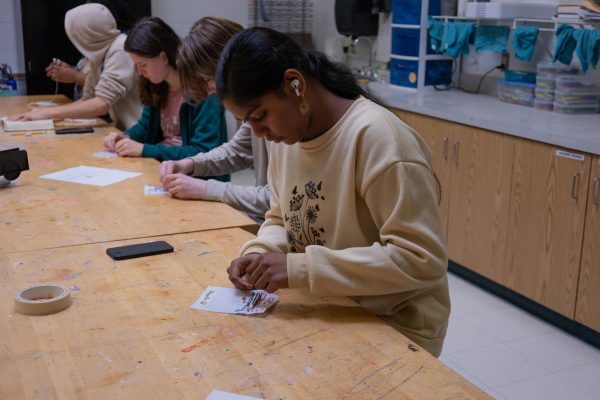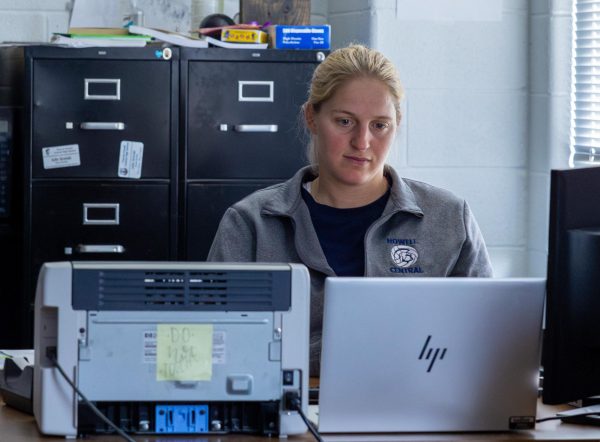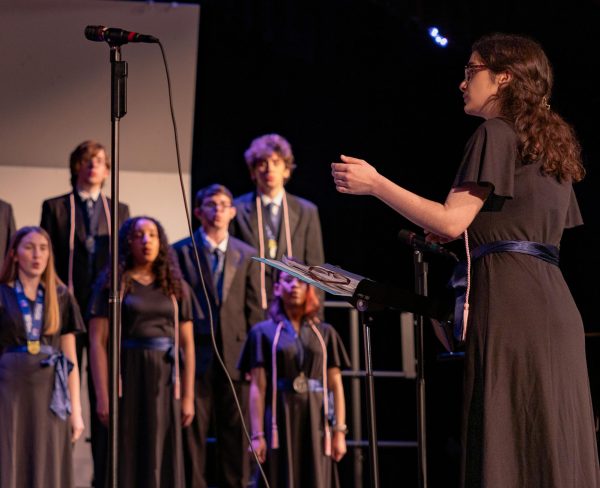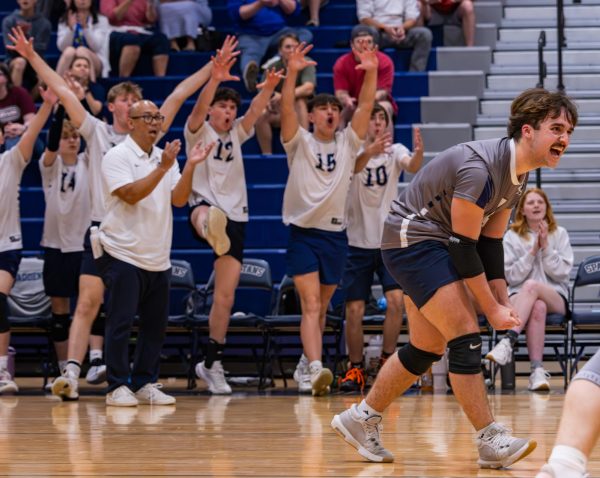Stars In The Shadows
The students off-stage that help make the on-stage magic happen
Photo Courtesy of Faith Carter
Backstage Beauties: The entirety of the theater department gathers in the gymnasium, including the crews that act behind the scenes to make the show a success. These 10 groups work collectively to provide the audience with a performance they will not forget.
Lights Crew:
Lights. Stage. Cue. The first thing seen when walking into the theatre are the various lights displaying rays across the stage, setting the scene as the crowd waits in anticipation for the show to begin. This scene is not set without the efforts of the numerous members of the light crew, headed by senior Mary Wachtel. Wachtel expands on how exactly lights add an extra dimension to the show.
“We make the stage brighter and bring warmth to the show with tons of color,” Wachtel said.
Sound Crew:
“Please silence your phones…” introduces the show before the performers come onto stage, ready to present a story to the audience. This phrase, along with many others, is an aspect of the performance that only the sound crew can accomplish. Sound crew head, Junior Krystal Arias, shares more about what her group is in charge of.
“We work on the sound effects for the show, microphones, voiceovers, pre-show music, intermission announcements, and all that fun stuff,” Arias explained.
Paint Crew:
The colors splayed across the scene is what makes the stage come to life. Without color, the scene would be bland. Thankfully, the paint crew devotes its time and efforts to setting the stage for the following performance. Senior Margaret Wilkerson shares what her crew must do to accomplish this task.
“We paint the sets and we paint the stage most of the time. We also paint a sign that goes out front of the show on the side of the road for passersby to see so they can come to the show,” Wilkerson said.
Set Crew:
The scene goes black. Shuffling is heard behind the curtain as the set is shifted into new positions, altering the scene for the next half of the play. Set crew makes this shift possible. The members build the large pieces used to construct the surroundings for the actors. They accomplish this task through the use of dimensional analysis and alterations of the pieces to fit the stage just right. Sophomore Kylie Christensen elaborates on what she tries to accomplish when she leads her team in constructing these objects.
“We want to give the audience that spark. When we open up the room with a set, it gives the audience the illusion that they are actually in the scene. We don’t want it to just be a box wall with a set, we want to give it a feeling. We want to give it emotion,” Christensen shared.
House Crew:
Streamers and lights hang from the ceiling. Billboards decorate the walls with props from the show. Pictures of the actors and actresses hang as they are admired by the audience strolling in.This decorated area, the hallway before the entrance to the theater, is referred to as the house and sets the mood for the performance waiting behind the double doors. House crew head Lily Klohr shares her experiences in terms of what the house contributes to theater.
“The house is the hallway after the double doors and we get to decorate it. It’s a little introduction to the show when people walk through the hall,” Lillie explained.
Hair and Makeup Crew:
Hair and makeup crew is in charge of transforming the faces of the crew, to make them into the characters they play. Their unique talents are applicable in every show and are able to completely change the aesthetic vibe of the actor or actress. Makeup can be used for multiple circumstances including altering the age, color, or liveliness of the facial features as a whole. Sophomore Emma Cowherd has recently occupied the position of crew head of hair and makeup and feels strongly that her crew contributes greatly to the show as a whole.
“We learn different techniques for hair and makeup. We look at past performances of the cast and research who the characters are to create a makeup style for them. For example, this show we have a school girl so we thought of doing pigtails and blush. We also use makeup to make the characters look either older or younger,” Cowherd said.
Costumes Crew:
What would a witch be without her pointy hat? Or a superhero without a cape? Or a little girl without her pink dress and bows? All of these characters are completed with a costume that fits their character’s personality. The audience sees the actors and actresses before anything else in the scene is processed, making the accuracy of costumes of the utmost importance. Junior costume crew head Emily Zuehlke explains how they strive to accomplish this necessary accuracy.
“We analyze the characters personalities and decide what designs, what costume, what aesthetic would best fit with their character. Then we graph out the designs, discuss them with the actors, and then go out shopping to buy everything that we need,” Zuehlke concluded.
Props Crew:
Props make the essence of theater come to life. A fairy without a wand is just a hag. An author without a pen is just a man. In order to experience this performance as reality, the scene must come to life. And the only way to display the actors as though they are the people they pretend to be, they need the props that make them who they are. Props crew is in charge of bringing this sense of realism to the show through the creation of these objects. Sophomore and props crew head Jenna Woelfel shares her feelings about the importance of props.
“It’s fun to see the props come to life. If you took away props, the show would be only hand-miming, there would be nothing used to visualize the stage as anything other than a stage,” Woelfel explained.
Publicity Crew:
There is no show without an audience. There is no audience if nobody is aware of the show. And there is no awareness of the performance without the publicity crew. This crew, though acting behind the scenes, is a necessary aspect of theater as a whole. Ms Melissa Dumas, crew head, speaks more on the importance of this “hidden” crew.
“Publicity creates the Playbill, designs/orders the play shirts, creates/designs the posters to promote the play/musical. We inform people of the show and make memories through the use of playbills and shirts. The playbills are important because they contain quotes of the cast and crew in it which the audience loves,” Dumas shared.
Pit Crew:
The clear sound of a plethora of musical instruments resonates throughout the auditorium from the pit below. Music builds in anticipation as the play reaches its climax. Sorrowful tunes serenade when a character is disheartened. The pit provides these musical tones to accompany the emotions of the scene unfolding. However, the musicians must practice and prepare to ensure their notes align with the words of the cast and the roles of their instruments fit with the roles of the characters. Vanessa Luan, senior, shares why she believes pit is a necessary aspect of theater.
“I think pit is the icing on top of cake. Sure, the cast can still perform without the pit, but it makes it so much better. It’s nice to have live background music instead of a recording to really engage the audience,” Luan explained.
Your donation will support the student journalists of Francis Howell Central High School. Your contribution will allow us to purchase equipment and cover our annual website hosting costs. FHCToday.com and our subsequent publications are dedicated to the students by the students. We hope you consider donating to allow us to continue our mission of a connected and well-informed student body.



